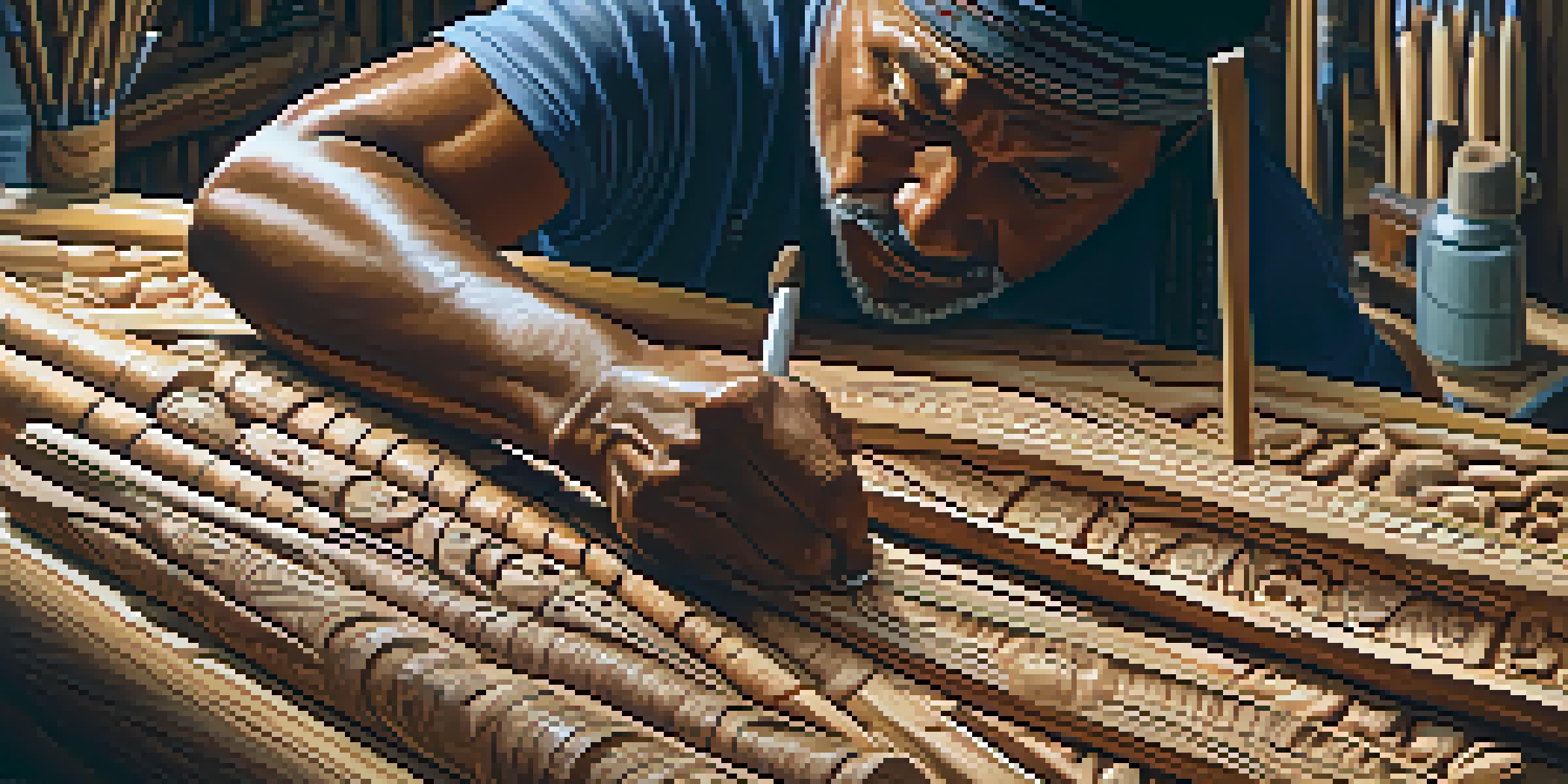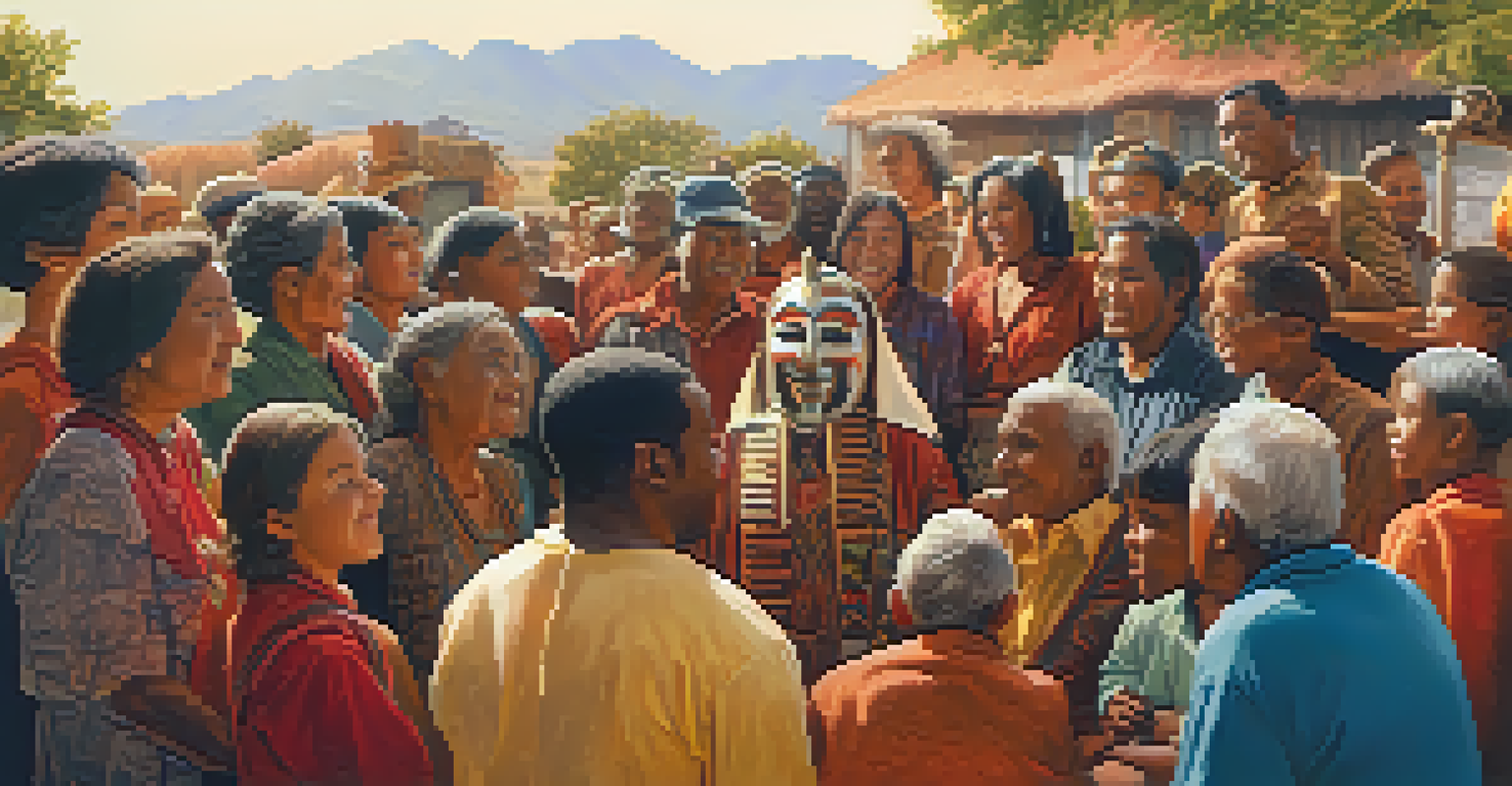The Role of Carving in Indigenous Storytelling Practices

Understanding Indigenous Storytelling and Its Importance
Indigenous storytelling is a vital cultural practice that conveys history, morals, and traditions. These narratives often serve as a way to pass down knowledge from one generation to the next, ensuring that vital cultural elements are preserved. Through stories, communities share their values, struggles, and triumphs, making storytelling an essential aspect of identity.
Stories are the most powerful way to put ideas into the world today.
Each story is unique and often tied to specific cultural practices, landscapes, or spiritual beliefs. They can take many forms, from oral traditions to visual representations, and are deeply embedded in the lives of Indigenous peoples. This rich tapestry of storytelling helps foster a sense of belonging and continuity within communities.
Carving plays a critical role in this practice, as it offers a tangible expression of these stories. Carved items, such as totem poles or masks, often embody the characters and themes found in oral narratives, creating a bridge between the spoken word and physical art.
The Art of Carving: Tools and Techniques
Carving is an ancient art form that involves shaping materials like wood, stone, or bone into intricate designs. Indigenous artisans have honed their skills over generations, using a variety of tools such as knives and chisels to create detailed carvings. These tools, often made from natural materials, are an extension of the carver's creativity and vision.

The techniques vary depending on the community and the specific story being told, with some carvings featuring stylized figures, while others may be more realistic. Each technique encapsulates the unique cultural heritage and storytelling traditions of the Indigenous group, making every piece of art a reflection of its creator's identity.
Indigenous Storytelling Preserves Culture
Indigenous storytelling serves as a vital cultural practice that transmits history, values, and traditions across generations.
The process of carving itself can be meditative, allowing artisans to connect with their ancestors and the stories they aim to portray. This deep connection to the craft ensures that each carving carries not just aesthetic value but also spiritual significance.
Symbolism in Carvings: More Than Meets the Eye
Carvings often carry rich layers of symbolism that can convey complex stories and messages. For example, an eagle might represent strength and freedom, while a bear could symbolize courage and leadership. These symbols are deeply rooted in the cultural beliefs and experiences of Indigenous peoples, making them an integral part of storytelling.
Art is the most beautiful of all lies; it is a story that tells the truth.
When a carving is created, the choice of symbols is not random; each element is thoughtfully considered to enhance the narrative being told. This adds depth to the stories, allowing viewers to engage with the artwork on multiple levels, often prompting reflection on personal and communal identities.
This symbolic language creates a dialogue between the carver and the audience, inviting them to explore the meanings behind the imagery. As a result, carvings become a powerful medium for sharing stories, fostering understanding and appreciation for Indigenous cultures.
Carvings as Storytellers: Engaging the Community
Carvings do more than just illustrate stories; they serve as communal storytellers that engage the audience. When displayed in public spaces, these carved pieces often prompt discussions among community members, encouraging them to share their interpretations and personal connections to the stories represented. This interaction helps to keep the storytelling tradition alive.
Moreover, community gatherings often feature storytelling sessions accompanied by carvings, creating a rich, immersive experience. This integration of visual art and oral tradition reinforces the importance of collaboration in Indigenous cultures, where sharing stories can strengthen community bonds.
Carving Connects Art and Narrative
Carvings not only illustrate stories but also embody symbols that enhance the narratives, fostering community engagement and cultural pride.
By involving the community in storytelling through carvings, these practices ensure that the narratives remain relevant and vibrant. This engagement helps to foster a sense of pride and ownership over cultural heritage, ensuring that Indigenous stories continue to resonate across generations.
Carving in Educational Spaces: Bridging Generations
Incorporating carving into educational practices helps bridge the gap between generations, allowing young people to connect with their heritage. Schools and community programs often include carving workshops, where elders can pass down their skills and stories to the youth. This hands-on experience fosters respect for traditional crafts and the narratives they represent.
These workshops not only teach practical skills but also emphasize the importance of storytelling within the context of Indigenous cultures. Participants learn that each carving has a story, and they begin to appreciate the deeper meanings behind the art they create.
This intergenerational exchange ensures that the wisdom and stories of the elders are preserved while empowering younger generations to become active participants in their cultural heritage. By learning the art of carving, they can contribute their narratives and perspectives to the ongoing story of their community.
Challenges Facing Indigenous Carving and Storytelling
Despite its significance, Indigenous carving and storytelling face various challenges today. Modernization and globalization have led to a decline in traditional practices, as younger generations may feel disconnected from their cultural roots. This can result in a loss of skills and knowledge that are crucial for maintaining these important traditions.
Additionally, issues such as appropriation can undermine the authenticity of Indigenous stories and art. When non-Indigenous artists imitate these practices without understanding the cultural context, it can dilute the meaning behind the carvings and stories, leading to misrepresentation.
Challenges Threaten Traditional Practices
Modernization and appropriation pose significant challenges to Indigenous carving and storytelling, risking the loss of essential cultural heritage.
Efforts to revitalize carving and storytelling practices are essential for preserving Indigenous cultures. This includes community initiatives, educational programs, and collaborations that prioritize the voices of Indigenous peoples, ensuring that their stories are told authentically and respectfully.
The Future of Indigenous Carving and Storytelling
Looking ahead, the future of Indigenous carving and storytelling is filled with potential for renewal and growth. By embracing modern technologies and platforms, Indigenous artisans can reach wider audiences, sharing their stories and art in innovative ways. This can help garner greater appreciation for their cultural heritage and the narratives they represent.
Furthermore, collaborations between Indigenous and non-Indigenous artists can create opportunities for cross-cultural dialogue. These partnerships can lead to a deeper understanding of Indigenous stories and the significance of carving, promoting respect and appreciation for diverse artistic traditions.

Ultimately, the resilience of Indigenous storytelling and carving practices lies in the strength of the communities that uphold them. By continuing to pass down their stories and art, Indigenous peoples can ensure that their rich cultural heritage remains vibrant and relevant for future generations.